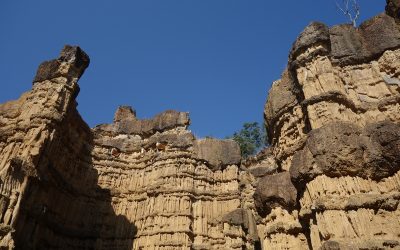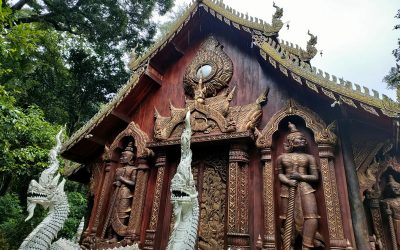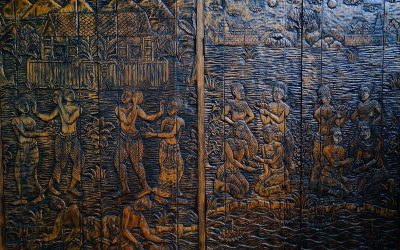Kew Mae Pan is among the best nature trails available in Chiang Mai’s national parks

There are many nature trails on Doi Inthanon, the favorite one is Kew Mae Pan which suitable for everyone who have limited of time. This trail is about 3 kilometers long take about 1-2 hours every groups need a trekking leader. You could see the Rhododendrons, commonly found in the Himalayas. This trail passing through wet and cold areas in a lush valley. Forest above 2,000 metres is covered with lichens and wild orchids. Indigenous plants that needs a high level of nutrition, organic deposits.
Kiew Mae Pan situates at approximately 2,200 meters above sea level, is 3.2 km. long and takes around 2-4 hours to complete. Visit 3 different type of forest that separate into 21 stations offer detailed explanations about the plants and ecosystems, whether it be ferns from ancient times, Himalayan flora species, dense cloud forest or grassland.
First Zone: Ancient Evergreen Forest
The journey begins in a serene evergreen forest, rich with ancient filmy ferns and a dense canopy that allows minimal sunlight. The forest floor, littered with leaves and organic matter, slowly decomposes due to the cold climate, maintaining a pristine environment. This area is a key watershed, capturing moisture from the clouds, and is home to rare plant species like Himalayan Rhododendrons and wild orchids.

1 Filmy Fern: Ancient Survivors
Your hike begins with the fascinating Filmy Fern at Station 1. These ancient plants, whose origins date back over 230 million years, are true survivors of the prehistoric era. The fern’s delicate leaves, only a single cell layer thick, are perfectly adapted to absorb moisture directly from the cloud-laden air. During dry spells, the ferns become crisp and curl up, but they quickly revive with the return of moisture, showcasing their incredible resilience.

2 Cloud forest Zone
As you ascend, the trail brings you into the cloud forest, where the temperature drops and clouds form, providing vital water through condensation. This ecosystem is characterized by a dense canopy, separated from the undergrowth, and is home to abundant epiphytes like orchids and ferns that cling to almost every trunk and branch.

3 Humble origin of a mighty river
At Station 3, you’ll observe a deep gorge that reveals the past course of a mountain stream. These streams, rich in oxygen from splashing against rocks, are vital to the watershed. All the streams in this area eventually flow into the Ping River, contributing to the Chao Phraya River and sustaining millions of lives in Thailand’s central plains.

4 The Plant Communities of the Cloud Forest
Station 4 showcases the diverse plant communities in the cloud forest, where trees like tropical oaks and Schima Wallichii dominate. The soil here is rich, boggy, and acidic, supporting a variety of ground-cover plants, particularly those from the Ginger family. However, few seedlings can grow where the leaf litter is too thick, highlighting the delicate balance of this ecosystem.

5 The Dynamic Nature of the Forest
High-altitude cloud forests like this one must endure strong winds that occasionally topple trees, allowing sunlight to penetrate and encouraging new growth. This dynamic process allows non-woody plants to flourish before the original trees gradually reclaim their territory. It’s a natural cycle of disturbance and recovery that maintains the forest’s biodiversity.

6 Vines – The Aerial Expressway
At Station 6, you’ll learn about the vital role of vines in the cloud forest. Unlike trees, vines do not invest energy in growing strong trunks. Instead, they rapidly climb toward the canopy by clinging to trees. These vines create a network of aerial pathways that animals like squirrels and civets use to move from tree to tree, showcasing the interconnectedness of the forest ecosystem.
Second zone: Cloud Forest and Panoramic Views
As you ascend, the forest transforms into a cloud forest where the cool temperature causes clouds to form, providing water through condensation. Here, the dense, cauliflower-like canopy is separated from the undergrowth, and the air is filled with the scent of orchids and ferns that thrive in the high humidity. Reaching the wind-swept savannah, you’ll find a semi-alpine meadow where the terrain is dry, with resilient plants that survive in harsh conditions.

7 Sub-Alpine meadow
As you continue, the trail leads to a sub-alpine meadow, a rare habitat at altitudes of 2,000-2,500 meters. Here, the poor soil, steep slopes, and frequent fires prevent forest recolonization, allowing hardy plants from the Himalayas to thrive. The meadow is a unique ecosystem where the constant battle between forest and meadow continues, with the meadow currently winning.

8 The fire-tolerant bracken fern
At Station 8, you’ll find bracken ferns that have adapted to survive in the harsh conditions of the sub-alpine meadow. These ferns thrive in damp gullies but can also withstand dry, windy conditions and occasional fires. Their thick leaves limit water loss, and their underground stems protect them from fire, allowing them to regenerate quickly after a disturbance.

9 The Panoramic Viewpoint
One of the trail’s highlights is Station 9, the panoramic viewpoint. Here, you can take in expansive views of the Doi Inthanon mountain range. The ever-changing clouds add a mystical quality to the scenery, making this viewpoint a perfect spot for reflection and photography. The views are always breathtaking, whether the landscape is shrouded in mist or bathed in sunlight.

10 Rocky Cliffs – A Safe Haven for Gorals
Station 10 introduces you to the rocky cliffs that serve as a natural habitat for gorals, small goat-like animals well adapted to the rugged environment. The gorals blend seamlessly with the gray-brown boulders, making them difficult to spot unless you look closely. These cliffs provide a safe refuge from predators, and the gorals’ sure-footedness allows them to navigate the steep terrain with ease.

11 Phar-Ngam Noi rock outcrop
At Station 11, you’ll come across the Phar-Ngam Noi rock outcrop, a striking geological formation shaped by centuries of erosion. The twin granite rocks stand as a testament to the enduring power of wind and water, which have slowly worn away the surrounding landscape. This outcrop is a reminder of the natural forces at work in the region, continually reshaping the earth over millennia.

12 The Kew Mae Pan Mountain Ridge
The Kew Mae Pan mountain ridge offers a striking contrast between the lush, green forest on the protected inner slope and the stunted trees on the sun and wind-exposed outer slope. This difference is due to the varying environmental conditions on either side of the ridge, with the outer slope facing harsher winds and more intense sunlight. The ridge serves as a natural boundary, dividing these two distinct ecosystems and highlighting the adaptability of the forest to its environment.

13 The Hardy Rhododendrons
As you reach Station 13, you’ll be greeted by the sight of hardy Rhododendron trees. These plants have thick, sticky leaves designed to minimize water loss in the windy, exposed conditions of the cliffs. Their bright scarlet flowers are not only beautiful but also serve an important ecological role, attracting sunbirds for pollination. The Rhododendrons’ ability to survive in such challenging conditions makes them one of the most iconic species on the trail.
Final zone: Returning to the Forest
After experiencing the rugged landscapes and panoramic views, the trail leads you back into the forest. As you descend, you’ll pass through a secondary forest where sun-loving pioneer species like reeds and bananas dominate. This final stretch offers a gentle return to the more sheltered and lush environment of the lower elevations.

14 TSecondary forest
Station 14 provides a glimpse into the secondary forest at lower elevations, where pioneer species of sun-loving plants, such as reeds and bananas, thrive. This area contrasts sharply with the cloud forest above, showcasing the diversity of ecosystems within the park and the adaptability of plant life to different environmental conditions.

15 The Watershed Forest
The cloud forest above acts as a massive sponge, capturing moisture from the clouds and slowly releasing it into the watershed below. This natural process is crucial for maintaining the flow of streams and rivers throughout the year, preventing flash floods during the rainy season and ensuring a steady supply of water during the dry months. The thick layer of leaf litter and humus in the forest helps to retain this water, gradually releasing it to nourish the forest and surrounding areas.

16 Moss – Water-Loving Survivors
At Station 16, you’ll find mosses growing abundantly around tree bases and damp rocks. These simple plants are among the first to colonize new surfaces, anchoring themselves with tiny root-like structures. Mosses thrive in moist conditions but can also survive periods of drought by becoming dormant. When conditions improve, they quickly revive, continuing their role in the ecosystem as pioneers and water retainers.

17 The Two generation forest
The final station highlights the “two-generation” forest, where trees of similar age and height indicate past disturbances, likely due to storms. This area showcases the resilience of the forest, as pioneer species quickly recolonize the land, creating a new generation of trees alongside the older, undisturbed areas. It’s a testament to the dynamic and ever-changing nature of the cloud forest ecosystem.

18 Tall Trees with Shallow Roots
Despite their towering height, the giant trees at Station 18 have shallow root systems that spread horizontally just below the surface. These roots help anchor the trees in the thin, rocky soil, but they also make them vulnerable to toppling during storms. Some trees develop buttress roots for added support, showcasing their adaptability in this challenging environment.

19 Tree Ferns – Guardians of the Gully
At Station 19, you’ll find tall tree ferns, the largest non-vascular plants in the forest. These delicate plants lack strong woody stems, making them vulnerable to damage, but they thrive in the wet, shaded gullies protected from strong winds and sunlight. Their presence indicates the health of this undisturbed part of the cloud forest.

20 Listening to Nature’s Symphony
At Station 20, take a moment to pause and listen to the natural sounds of the forest. The rustling leaves, the chirping of birds, and the trickling streams create a soothing symphony that immerses you in the forest’s serene atmosphere. This station encourages visitors to connect deeply with nature, appreciating the subtleties of the environment.

21 Summary – An Outdoor Classroom
The final station serves as a summary of your journey through the Kew Mae Pan Nature Trail. It highlights the trail as an outdoor classroom, where visitors can learn about the complex ecosystems, evolutionary adaptations, and the importance of conservation. This station reinforces the idea that while humans cannot create such wonders, we can cherish and protect them for future generations.

Entrance Ticket : A trek on the Kew Mae Pan Nature Trail costs 200 baht, which includes a local guide. The small group sizes, limited to 15 people, ensure a personalized experience where you can fully engage with the natural beauty and educational aspects of the trail.
How to get to Kew Mae Pan Nature Trail :
To reach Kew Mae Pan Nature Trail, head to Doi Inthanon National Park, approximately 110 km from Chiang Mai. The trailhead is located at the 42 km marker on Highway 1009. The best time to visit is between November and May, when the trail is open and the weather is ideal for trekking.
======== Related Posts ========
Pha Chor
Pha Chor: The Grandeur of Nature's Sculpture at Mae Wang National ParkTucked away in the verdant wilderness of Mae Wang National Park in Northern Thailand lies Pha Chor, an awe-inspiring geological formation steeped in millennia of history and natural transformation....
Wat Luang Khun Win
Wat Luang Khun Win : A Hidden Treasure in Chiang MaiHey folks, are you ready for an off-the-beaten-path adventure in Chiang Mai? Get ready to feast your eyes on a hidden gem - Wat Luang Khun Win. Nestled in the heart of a vibrant forest, this little-known temple is...
Baan Tawai
Baan Tawai: Thailand's Treasure Trove of HandicraftsBaan Tawai Handicraft Village : A Treasure Trove of Thai Crafts and CultureBaan Tawai Handicraft Village is a hidden gem nestled in the Chiang Mai province of Northern Thailand. This small, picturesque village has...



